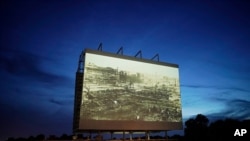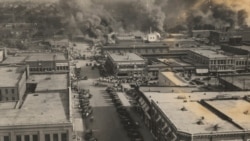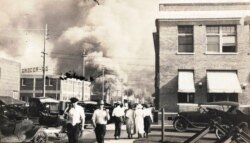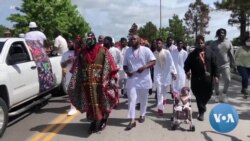U.S. President Joe Biden is headed Tuesday to Tulsa, Oklahoma, to commemorate the centennial of the Tulsa Race Massacre, a white mob’s terrifying 1921 destruction of a Black community that left 300 people dead and 10,000 homeless.
Biden will tour the Greenwood Cultural Center and give a speech there to mark the 100th anniversary.
To this day, what happened in Tulsa is an episode in the country’s fraught history over racial violence that many Americans have little awareness of, even as the country grapples with a current-day racial reckoning to confront accusations of police abuse of minorities, racial economic inequity and contentious debates over newly enacted voting restrictions that critics say are aimed at curbing the turnout of Black and Hispanic voters to limit their influence.
There appear to only be three remaining survivors, all centenarians, of the destruction of the prosperous Tulsa community known as Black Wall Street. The racial attack occurred four decades before the often-violent Civil Rights Movement of the 1960s that secured voting rights for Black Americans even as the debate continues now over voting access.
As Biden arrives in the city of 400,000 in the southwestern United States for the commemoration of the horrors of May 31-June 1, 1921, a new museum is opening to chronicle what occurred. But questions remain over whether to pay reparations -- and how much -- to the remaining survivors and descendants of the assault and how to search the unmarked, suspected burial grounds for those killed in the massacre.
One of the survivors, Viola Fletcher, 107, recently appeared before a congressional panel in her first trip to Washington to make the case for reparations while recounting her memories from the attack on her neighborhood when she was a 7-year-old girl.
“On May 31, of ‘21, I went to bed in my family’s home in Greenwood," she said. “The neighborhood I fell asleep in that night was rich, not just in terms of wealth, but in culture … and heritage. My family had a beautiful home. We had great neighbors. I had friends to play with. I felt safe. I had everything a child could need. I had a bright future.”
“Within a few hours,” Fletcher said, “all of that was gone.”
"The night of the massacre, I was awakened by my family,” she recalled. “My parents and five siblings were there. I was told we had to leave and that was it. I will never forget the violence of the white mob when we left our home. I still see Black men being shot, Black bodies lying in the street. I still smell smoke and see fire. I still see Black businesses being burned. I still hear airplanes flying overhead. I hear the screams.”
Fletcher, her brother, Hughes “Uncle Red” Van Ellis, who is 100, and a third survivor, Lessie Benningfield Randle, 106, are the lead plaintiffs in a reparations lawsuit filed last year against the city of Tulsa, Tulsa County, the state of Oklahoma and the Tulsa Chamber of Commerce. They contend that the defendants are responsible for what happened during the massacre.
"I have lived through the massacre every day,” Viola Fletcher told the congressional panel. “Our country may forget this history, but I cannot. I will not. And other survivors do not. And our descendants do not.”
A hundred years ago, Greenwood — the Black Tulsa neighborhood that includes the area known as Black Wall Street — was burned to the ground and the virtually all-white Tulsa Police Department joined in the attack, deputizing white mobs and providing them with arms. The massacre was triggered by accusations that a 19-year-old Black man had assaulted a 17-year-old white girl in an elevator.
Numerous reports of the time described white policemen with badges setting fires and shooting Black people as part of the Greenwood invasion.
But the violence of 1921 was largely ignored for decades if not forgotten. Then-Tulsa Police Chief Chuck Jordan stood in Greenwood in 2013 and apologized for the department's role.
"I can't apologize for the actions, inaction or derelictions of those individual officers and their chief," Jordan said. "But as your chief today, I can apologize for our police department. I am sorry and distressed that the Tulsa Police Department did not protect its citizens during the tragic days in 1921."
The commemoration of the events of 100 years ago, however, has been caught up in the disputes of 2021.
The Tulsa Race Massacre Centennial Commission abruptly canceled a “Remember and Rise” concert “due to unexpected circumstances.” Singer John Legend had been scheduled to perform and a keynote speech by voting rights activist Stacey Abrams was planned.
Oklahoma Governor Kevin Stitt was ousted from the centennial commission after he signed legislation that would prohibit public school teachers from teaching about “critical race theory” that recounts the 17th century history of slavery in what more than a century later became the United States.
Greenwood Rising, a new museum to commemorate the 1921 massacre, is opening this week, but some in Tulsa are denouncing the commission and instead focusing on the remaining survivors and descendants of the attack. As Biden visits, the city is resuming its excavation of a suspected mass grave where victims of the massacre are believed to be buried.
WATCH: Biden to Visit Tulsa as Nation Reflects on Race and Reparations
The extent of reparations remains paramount to remembering the massacre. Oklahoma state Senator Kevin Matthews, who chairs the centennial commission, told reporters last week that lawyers for the survivors had initially sought $100,000 each and a $2 million donation to a reparations fund, which the commission had agreed to. But he balked at what he said were later demands for $1 million for each survivor and a $50 million for the fund, although the survivors’ lawyers disputed his claims.
“There was never a non-negotiable demand for $50 million dollars,” the lawyers said. “The non-negotiable issues were that the fund would provide direct financial support to survivors and descendants and that the fund would be administered by descendants and North Tulsa community members, and the fund be held in a Black bank.”
Tulsa Mayor G.T. Bynum said the city has been working with Oklahoma and federal officials to make sure “people who want to participate in activities and mourn this event, the worst event in our city’s history, feel comfortable being in public doing that with different groups coming to town.”
“It’s the classic case of hope for the best and prepare for the worst,” said Bynum, who reopened the search for mass graves from the massacre.










